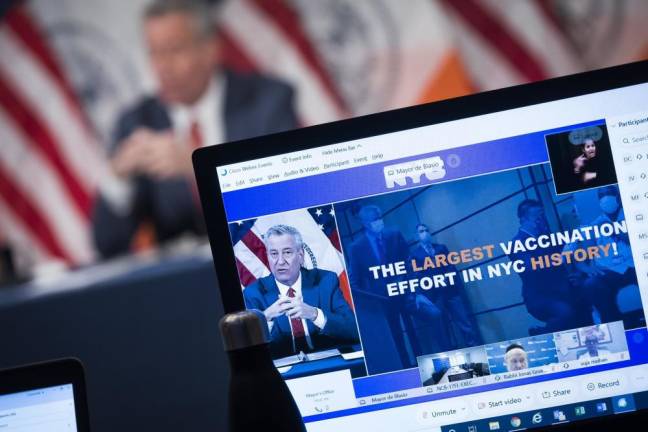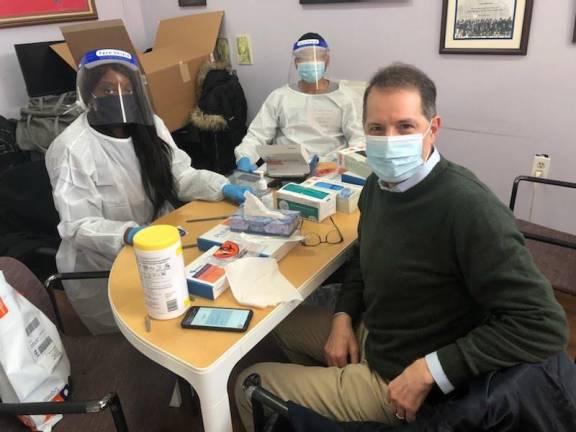A Slow Vaccine Rollout
UPDATED: Mayor de Blasio’s one million pledge is fuzzy and falls short of what is needed to immunize New York by summer


At this rate, it will take nearly two years or more to vaccinate New York.
The arrival of the vaccines – not one, but two – felt like a Christmas miracle. But they are being distributed at a pace that feels more like crosstown traffic at Christmas before the pandemic.
“We are going to have to dramatically increase the pace if we are going to get the whole city done by the middle of the year,” said the chair of the City Council health committee, Mark Levine. “With being somewhat understanding of start up challenges, it’s pretty clear we need to pick up the pace dramatically.”
In response, Mayor Bill de Blasio announced on New Year’s Eve his resolution for January that “we will vaccinate a million New Yorkers. A million people we will reach in January. This city can do it.”
To achieve this the city is setting up emergency vaccination centers in schools, community centers and other locations and recruiting municipal employees to staff them.
In his determination to show “urgency,” the mayor may have overstated the goal. His health commissioner, David Choksi, who took office in the middle of the pandemic, explained moments later at the same New Year’s eve news conference that the launch of city run vaccination centers would begin in mid-January and that the city would send nurses and pharmacists to administer vaccines through community based organizations by the end of January.
“This would be like our flu campaign in overdrive,” Choksi said. “Growing capacity through these initiatives, along with our existing hospital, clinic, and pharmacy infrastructure gets us to the ability to administer a total of one million doses by the end of January.”
The ability to administer a million doses by the end of January is rather different from immunizing a million people in January.
But setting aside these blurry details, familiar to followers of the de Blasio administration across many topics, the city Health Department has not tried to conceal the scale of the challenge. The vaccination numbers posted on their website, and updated each day, will surely become as widely followed as positivity rates and hospital admissions have been in earlier phases of the crisis.
Here are the basics. As of January 4, 391,400 doses of the Pfizer and Moderna vaccines have been delivered to the city. Of those, 104,910 doses have been administered to New Yorkers, mostly health workers and seniors in nursing homes.
This glimmering of good news has understandably been the feel-good story of the last few weeks. The creativity of New Yorkers has been captured in the number of ways they have found to express the thought of light at the end of the tunnel.
“One metaphor is that we are a row boat on a stormy sea,” said Levine, who suffered a bout of COVID-19 himself, “Thanks to vaccine we can see the shoreline off to the distance. We still have to do the hard work.”
Herd Immunity
But here is the rub. On the best days so far, doses were administered at that a rate that will take more than a year and eight months to vaccinate 6 million New Yorkers.
That, of course, is not all New Yorkers. But it is a useful number for several reasons.
It is close to the 75% of the population who must be immunized to create the coveted “herd immunity” that naturally suppresses the virus. Also, there is no vaccine yet approved for children under 16, close to 20% of the population.
Six million is also the number inoculated in the last mass effort, against smallpox in 1947. That took a month. “We did it in 1947,” Levine said. “We can do it now.”
This will require a ten-fold increase in the vaccination rate, Levine said, to about 400,000 a week, or more than 1.6 million a month.
Beyond transferring city workers from other duties, the city should hire unemployed New Yorkers to ramp up the effort.
“Implementing a mass-scale COVID vaccination program would be extremely expensive,” Levine wrote. “SO WHAT?!? Lives are on the line. And every week we shorten this pandemic is worth billions of dollars in economic activity.”
But how far off is the date marking the end of the pandemic?
As Levine noted, that distant shore is thought of by most people as the middle of next year - call it a hope, even an expectation. That time frame is often cited by federal and local officials.
A lot is riding on this idea. A well known not-for-profit has put its fall fundraising gala back on the schedule for 2021. A California couple has booked travel to the east coast for next August in the expectation that reunions with family and friends will be safe by then. And a therapist in Greenwich Village reports that she has tried to dispel her own lockdown fever by booking a trip to Greece for next October.
“I don’t even know if I will actually go,” she said. “But it helps to have it.”
Lives On Hold
These lives on hold are just pinpoints in the economic, social and educational energy of New York yearning to be unleashed again.
So far, most discussion has focused on whether there will even be enough vaccine manufactured. Pfizer’s pre-Christmas commitment to deliver a second 100 million doses by July puts the country close to enough vaccine, but not quite there. Federal officials have been optimistic that other vaccines, currently in trial, will be approved and fill out the supply early next year.
What the early days make clear, however, is that the bigger challenge may be getting that vaccine from the manufacturers into people’s arms.
Another way of describing New York City’s early performance is that after the first three weeks it had administered only about 26% of the vaccine doses it had received. “I’m hopeful we will learn and logistics won’t hold us back,” said Levine. “It is essential that as soon as we get a shipment we can move it out the door.”
New York is hardly alone. Many communities are working out distribution kinks. Chicago and the state of Illinois got off to the best start, administering more than 100,000 doses in the early days. “The vaccine team in Illinois sprinted past them all in week one,” said Governor J.B. Pritzker.
It is reasonable to assume health systems will get better, but it is also true that the challenge will get much larger.
For one thing, so far everyone is receiving their first dose. But beginning soon, those who received a first dose in mid-December will need to come back for their second even as thousands of other New Yorkers are receiving their first.
The United Kingdom, administering a different vaccine made by Astra Zeneca, is delaying second doses to give more people a first dose. A health department spokesperson didn’t reply to a request for the city’s view of that.
So far, all the doses are being administered in existing institutional settings, from major hospitals, to nursing homes, to the Fire Department training academy on Randalls Island, where emergency medical technicians, who have been among the most exposed frontline workers, were the first FDNY staff to get the vaccine.
“We need some type of normalcy,” EMT Capt. Mary Merced said as she received an early jab. Merced said she hasn’t hugged her grandchildren since March. “This has gone on too long.”
But to bring the pandemic to an end, the vaccination campaign will have to reach many New Yorkers beyond existing systems of distribution. “We need to get to the point you can get the vaccine anywhere you can get the flu vaccine and go way beyond that,” Levine explained. “In marginalized neighborhoods, we will need public schools, maybe places of worship, meeting people where they are comfortable.”
“We are going to have to dramatically increase the pace if we are going to get the whole city done by the middle of the year.” Council Member Mark Levine